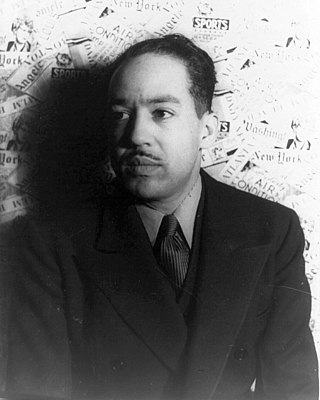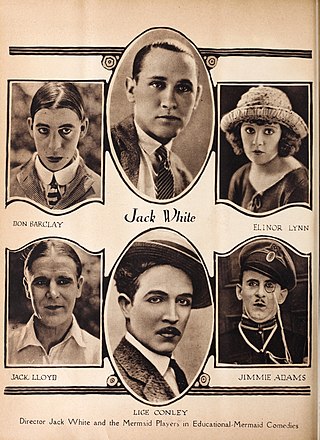
Ben Hecht was an American screenwriter, director, producer, playwright, journalist, and novelist. A journalist in his youth, he went on to write 35 books and some of the most enjoyed screenplays and plays in America. He received screen credits, alone or in collaboration, for the stories or screenplays of some seventy films.

Karamu House in the Fairfax neighborhood on the east side of Cleveland, Ohio, United States, is the oldest producing Black Theatre in the United States opening in 1915. Many of Langston Hughes's plays were developed and premiered at the theater.

James Edwin Campbell was an American educator, school administrator, newspaper editor, poet, and essayist. Campbell was the first principal of the West Virginia Colored Institute from 1892 until 1894, and is considered by the university as its first president.

The Harlem Renaissance was an intellectual and cultural revival of African American music, dance, art, fashion, literature, theater, politics and scholarship centered in Harlem, Manhattan, New York City, spanning the 1920s and 1930s. At the time, it was known as the "New Negro Movement", named after The New Negro, a 1925 anthology edited by Alain Locke. The movement also included the new African American cultural expressions across the urban areas in the Northeast and Midwest United States affected by a renewed militancy in the general struggle for civil rights, combined with the Great Migration of African American workers fleeing the racist conditions of the Jim Crow Deep South, as Harlem was the final destination of the largest number of those who migrated north.

Flournoy Eakin Miller, sometimes credited as F. E. Miller, was an American entertainer, actor, lyricist, producer and playwright. Between about 1905 and 1932 he formed a popular comic duo, Miller and Lyles, with Aubrey Lyles. Described as "an innovator who advanced black comedy and entertainment significantly," and as "one of the seminal figures in the development of African American musical theater on Broadway", he wrote many successful vaudeville and Broadway shows, including the influential Shuffle Along (1921), as well as working on several all-black movies between the 1930s and 1950s.

Aubrey Lee Lyles, sometimes credited as A. L. Lyles, was an American vaudeville performer, playwright, songwriter, and lyricist. He appeared with Flournoy E. Miller as Miller and Lyles as a popular African-American comedy duo from 1905 until shortly before his death. in 1929 they appeared on film as grocers in the Vitaphone Varieties short comedy film They Know Their Groceries.

Thomas Hayes Hunter was an American film director and producer of the silent era. He directed a total of 34 films between 1912 and 1934.

James Mercer Langston Hughes was an American poet, social activist, novelist, playwright, and columnist from Joplin, Missouri. One of the earliest innovators of the literary art form called jazz poetry, Hughes is best known as a leader of the Harlem Renaissance. He famously wrote about the period that "the Negro was in vogue", which was later paraphrased as "when Harlem was in vogue."
A number of theatre companies are associated with the Harlem Renaissance.

Established on June 18, 1904, Chicago’s Pekin Theatre was the first black owned musical and vaudeville stock theatre in the United States. Between 1904 and around 1915, the Pekin Club and its Pekin Theatre served as a training ground and showcase for Black theatrical talent, vaudeville acts, and musical comedies. Additionally, the theatre allowed “African-American theatre artists with an opportunity to master theater craft and contribute significantly to the development of an emerging Black theater tradition”. It was known by various names.

Benjamin Bowles Hampton (1875–1932) was an American film producer, writer, and director. He led a 1916 plan to conglomerate film companies via acquisition. He was married to actress Claire Adams and was a partner in Zane Grey Pictures. He wrote the History of the American Film Industry from Its Beginnings to 1931. He is credited with producing numerous films.

Russell Ball was an American studio glamour photographer who made stills for films and portraits of Hollywood film stars including Jean Harlow, Greta Garbo, Louise Brooks, Mary Pickford, Esther Ralston and Carol Dempster.

A film exchange was a business in film distribution that rented out movies to theaters. They opened up all over the United States to handle film reels during the silent film era.
Marion A. Brooks was an actor, playwright, and theater businessman. He partnered on the Bijou theater company at the newly established Bijou Theater in Montgomery, Alabama with players from Chicago. After it folded, he returned to work at the Pekin Theatre in Chicago.
As the World Rolls On, also known by its working title The Heart of Jack Johnson, is a 1921 drama film starring Jack Johnson. It was an Andlauer Productions film. It was advertised as featuring an "All-Star Colored Cast". The film features footage of National Negro League baseball games. It is a 7-reel film.

Mermaid Comedies are comedy short films that were produced in the United States. They were distributed by Earle W. Hammons' Educational Pictures and were at the high end of its comedy series brands.
Harrison Stewart was a comedic actor and lyricist in the United States. He performed at the Pekin Theater in Chicago where he became a star and received top billing.

Saint Suttle, was an American composer and performer. Suttle was well known as a cakewalk artist and vaudeville performer in Chicago. An African American, he was a pioneering performer in early film of the late 19th-century.

The Rag-Time Four was an American Quartet performance group circa 1898 to 1899, they were known for popularizing a version of the cakewalk dance. The four members of the group were Saint Suttle, Gertie Brown, John Brewster, and Maud Brewster. Suttle and Brewster were called the "Blackville Twins", while their female partners were called "their best girls". The group performed vaudeville in Chicago, along with in Milwaukee and Duluth. One of the groups cakewalk events was named Coontown 400.
Ernest Howard Culbertson, also known as E. H. Culbertson and Howard Culbertson, was an American newsreel editor, journalist, playwright, and screenwriter. Educated in Washington D. C., Culbertson began his career working for William Randolph Hearst as a features writer for The Washington Times. A pioneer in newsreel journalism, he was appointed head of the features department for William Fox's newly created Fox News in 1919; the organization that invented the newsreel. He later worked as a newsreel editor for Universal Newsreel. As a dramatist he is best known for the play Goat Alley which was first staged on Broadway in 1921 and later revived in 1927. He also wrote screenplays for films made by Pathé Exchange and Paramount Pictures, and was a writer for the 1937 CBS Radio program Living Dramas of the Bible.












